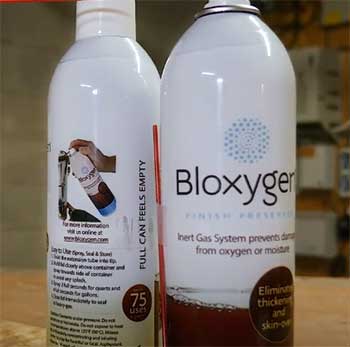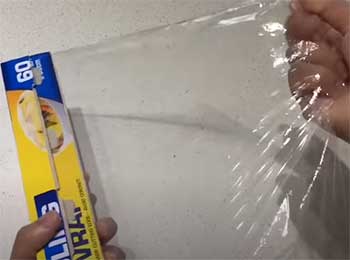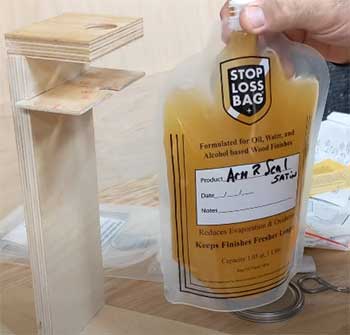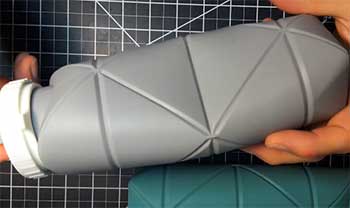Bloxygen is an innovative formula made to preserve any leftover paint, finishes, or food. It is a powerful product that saves the stated materials from reacting with moisture and oxygen thus preventing damage.
This is made from a heavy inert natural gas called Argon. The formula is top-notch but not the only available preservative. Let’s investigate some alternatives!
Bloxygen Substitutes to Preserve Your Woodworking Items
Now that you know what Bloxygen is, let’s look into its substitutes:

- Plastic Cling Wrap
- Compressed Gas Dusters
- Outherland Welles Tung Oil Products
- Stop Loss Bags
- Nitrogen
- Turning The Can Upside Down
- Collapsible Plastic Bottles with Photo Chemicals
- Any Of the Inert Gases on The Periodic Table
As you can see, there are several alternatives.
So as the buyer, you have the freedom to choose whichever suits your preference.
This article will now familiarize you with the alternate products. Most of the alternatives are quite cheaper.
- Plastic Cling Wrap

That’s right, you read correctly, it is the basic plastic cling wrap. This is low budget and very convenient to find!
Just use the plastic cling wrap as you would with any other basic product you use it for.
Once you are done with varnishing or painting, float the wrap over the surface of the container and wrap it tightly on the sides to ensure a firm seal has been made.
You’ll also dry ice chips for this technique.
Once the wrapping has been taken care of, take your dry ice chips and lay them on top of the plastic cling wrap for a few minutes. This little trick ensures that any remaining air remaining in your leftover paint/varnish has been completely displaced.
This substitute is rather DIY and very cost-efficient!
- Stop Loss Bags

Stop loss bags are of course a great substitute.
They will allow you to preserve the quality of fresh, ready-to-use wood finishes.
Each of these bags has the capacity to hold up to 1.05 liters or 1.0 liters.
Using this not only saves materials but also saves time.
The specially formulated 3-layer construction prevents solvent loss while a special air barrier prevents oxygen from entering the bag which keeps your leftover safe and sound.
This substitute is a great option for several reasons. First, it is the precise perfect size for one-quart cans of varnish and is environmentally friendly, meaning there are no more of skinned-over varnish cans.
There are no lap marks, which means the outcome received is more consistent.
It comes with a perfect retainment of solids-to-solvents ratio in case of fresh varnish.
These bags are very user-friendly since they are easy to open and close, and saves you from the trouble of prying off the lids to get them open and then pounding them back on to seal them shut. It is also quite easy to remix or stir satin, semi-gloss and matte finishes.
Finally, since this is transparent, you can easily see through the clear bag and know when you’re done. This feature is a very convenient plus point for this substitute.
Stop loss bags have been blooming quickly in the market with more than enough satisfied customers to ensure the fact that it is truly reliable and worth the money.
- Turning The Can Upside Down
This isn’t exactly a substitute product, but a method.
It may sound unreliable and like a complete fluke but if you want to save money and are willing to put up with a little extra hassle of sealing you can tight enough and wait for the leftover to reach back all the way to the bottom when you’ll reopen it for usage, then simply flip over that container!
But of course, in this modern day and age where we have the finest technology giving us incredible and reliable inventions, a few bucks extra spent to preserve leftovers is a great option.
Turning over the container is just considered advice you can keep at the back of your head to preserve your leftovers if the situation demands it.
- Nitrogen
This substitute is relatively cheap. While not an inert gas, nitrogen is a rather inactive element and is unreactive with many elements at room temperature, so it can easily get the job done.
Be aware that you will need a tank and regulator for any gas you use other than Bloxygen; they are both rather expensive and must be purchased from a gas provider.
- Compressed Gas Dusters
The spray from a compressed gas duster is significantly denser and heavier than even Bloxygen, which makes it extremely successful at removing all oxygen from a finish can.
It functions flawlessly without any peeling or changes to the quality of the finish. The gas duster is thus an ideal replacement for oxygen for oil finishes.
Compressed gas duster cans are available online for only $5-$6 each, as opposed to Bloxygen’s cans of $13 each. Not only are they more affordable but they also last longer.
You can also use them for dust removal before finishing, this is truly a win-win situation!
- Collapsible Plastic Bottles with Photo Chemicals

This method is quite DIY.
What needs to be done here, is once you get your collapsible plastic bottle, pour in some of that photochemical into the bottle on top of your leftover and then just squeeze the air out of the bottle and finally seal it shut.
This works because some photo chemicals degrade the presence of any oxygen in the air.
Of course, this is yet another technique to reach out for if you’re into DIY and trying to save some money.
- Outherland Welles Tung Oil Products
This can be purchased at $32 + a quart. The products work great but need a little maintenance since they can easily turn into jelly. But as stated, there are ways to keep it fresh for as long as you need.
One of the ways is to use only one pot at a time. Leave no gaps when applying the finish. Instead, pour a small amount of the finished product into a small container like a plate of “frozen pot pie”.
Another way is to pour the one-quart capacity into smaller sealed jars (baby food jars, mason jars, cheese jars, etc.) and fill them on top so that no oxygen/minimum amount of oxygen gets in.
- Any Of the Inert Gases on The Periodic Table
It has been discussed previously that you can use nitrogen. However, based on availability and pricing, it’s completely fine for you to choose any inert gas you prefer!
Since they are inert, they are safe to work with. They will displace oxygen hence the job is done.
Your options also include carbon dioxide, propane, butane, etc. but these require certain specific precautions and proper methods which you will be informed about at the store.
Conclusion
You know now that there is in fact a wide range of existing products that are very reliable for Bloxygen alternatives. Since Bloxygen can be of high price, it may not be affordable for everyone.
The substitute products come in a range of manufactured items from DIY-based methods to naturally occurring gases. These alternatives will surely save your day!
